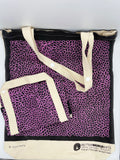Cotton Shopping Bag Foldable
This cotton shopping bag is a cross cultural project, designed in Australia and handmade by artisans overseas. Better World Arts brings together the traditional crafts of remote traditional communities and Aboriginal art, bringing benefits to all. Images are printed digitally and the bag has two clasps to keep it secure when folded and not in use, making it very easy to slide into your every day bag.
The Designs:
・Spirit Man (This design is owned by Stephen Pitjara Martin)
Stephen paints the Spirit Man in his country, Alyawarre in Central Desert. He uses different symbols to show familiar things. Rocks, waterholes, boomerangs, spears, and digging sticks.
・Wati Inma - Men's Ceremony (This design is owned by Rama Kaltu Kaltu Sampson
Rama's painting illustrates people sitting at an inma (ceremony) out Pipalyatjara way. There are wati tjuta, munu minma, munu tjiti tjuta, walytja tjuta (many men, women, children, and families) sitting, singing, and talking - each circle represents a person. This is taking place in Rama's country, Kuntjanu, and all the people are looking to see what is going to take place.
・Kuntjanu - Mingkiri Tjukurpa - Marsupial Mouse Dreaming (This design is owned by Rama Kaltu Kaltu Sampson)
Rama's painting illustrates the Mingkiri Tjukurpa - Marsupial Mouse Dreaming. This is part of the Wanampi (Rainbow Serpent) Dreaming. The Mingkiri People cry when the Wanampi (Rainbow Serpent) is speared. Other People in these stories include kuniya (python) and liru (snakes).
・Ngurunderi - Murray River Design (This design is owned by Cedric Varcoe)
When Ngurunderi came down the Murray River in his canoe, chasing the big Murray Cod, they formed the Murray River, Lakes and everything in Ngarrindjeri Country. He also made the Ngarrindjeri people, who live in the River Murray, Lakes, and Coorong. He taught everyone the lore, dance, song, and everything they needed to survive and live day to day.
・Walka - Damper Design ( This design is owned by Carol Young)
Walka is any meaningful mark or pattern, and may be an image on a cave wall, rock, or drawn in the sand, and has cultural and ritual significance. Walka is also used on the body during inma (ceremony). This painting resembles the small seeds that are collected for grinding into damper in the desert.















